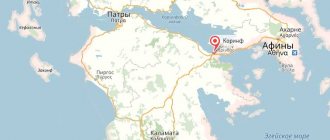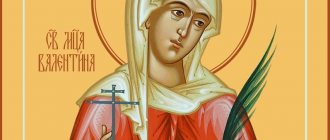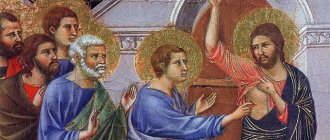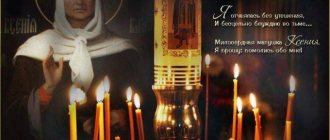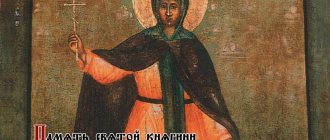| Ap. Luke the Evangelist. Icon, 1350-1360, Deesis tier of the iconostasis of the Athos Vatopedi Monastery. From the site ruicon.ru |
Luke
(+ c.), apostle from 70, evangelist, companion of the holy Apostle Paul, hieromartyr, physician, first icon painter Memory April 22, June 20 - for the transfer of relics (Greek [1]), October 18, in the Council of the Seventy Apostles, Achaian saints (Greek [2]) and Boeotian saints (Greek [2])
A native of Antioch in Syria [3]. He came from an enlightened Greek environment and was a Roman citizen. He became a doctor. Was not married [4].
Having heard about Christ, he arrived in Palestine and there he ardently accepted the saving teaching from the Lord Himself. Among the 70 disciples, he was sent by the Lord to preach the first sermon about the Kingdom of Heaven during the Savior’s life on earth (Luke 10:1-3). After the Resurrection, the Lord Jesus Christ appeared to him and Cleopas, who were going to Emmaus.
He took part in the second missionary journey of the Apostle Paul, and since then they have been inseparable. Saint Luke was present at the conversion of Lydia and her household, and he himself lived in her house. About him, together with the Apostle Paul, Timothy and Silas, a woman possessed by a prophetic spirit shouted: “These men are the servants of the Most High God, who proclaim to us the way of salvation” (Acts 16:17). He and Timothy were not taken into custody along with the Apostle Paul and Silas, probably because they did not look like Jews. When the apostle Paul left Philippi, Luke stayed behind to continue preaching the gospel—he was still there when Paul visited Philippi again.
When Saint Paul left Greece and went to Asia Minor, Luke accompanied him to Troas. Became an eyewitness to the attack on the Apostle Paul in Jerusalem on the steps of the Antonian Fortress and often visited him during his two-year stay in Caesarea. Then, together with Aristarchus, he accompanied Paul on his way to Rome, and with him survived the most dangerous sea voyage from Crete to the island of Melitus during a multi-day storm. He was next to Paul during the two years that he lived in custody in Rome. Probably at this time, in the years, under the leadership of the Apostle Paul, he wrote the Gospel and the book of the Acts of the Holy Apostles [5]. Saint Paul mentions him by name in his letters to the Colossians (Col. 4:14) and Philemon (Phil. 1:24), as well as in the second letter to Timothy, from which it is clear that when all his co-workers left Paul, the Apostle Luke continued to share with with him all the difficulties of the evangelistic feat (2 Tim. 4:10). Saint Luke was also present at the martyrdom of the Apostle Paul.
After the martyrdom of the chief apostles, he left Rome and preached through Achaia, Libya, Egypt and Thebaid [6].
He ended his earthly journey as a martyr in the city of Thebes, Greece. There is a legend that Saint Luke was crucified on an olive tree. At the same time, Julius Africanus does not talk about martyrdom, but only indicates that Saint Luke died at the age of seventy-four, “filled with the Holy Spirit” [7].
Tradition credits him with painting the first icons of the Mother of God. “May the grace of Him who was born of Me and My mercy be with these icons,” said the Most Pure Virgin, seeing the icons. Of the famous miraculous icons of the Most Holy Theotokos, Tradition attributes more than seventy icons to the authorship of the Apostle Luke. He also painted icons of the holy chief apostles Peter and Paul.
| St. Evangelist Luke. Russian icon |
Relics and veneration
He was originally buried in Thebes. His tomb was a Roman marble tomb, made in pre-Christian times and probably acquired immediately after his death. According to local legend, this tomb, for several centuries after the death of St. Luke, exuded a miraculous paste-like substance, called “kolidio” by the Greeks, which healed eye diseases.
In 356, by order of Emperor Constantius II, the relics of Saint Luke, together with the relics of the Apostle Andrew the First-Called, were transferred to Constantinople and buried in the ground in the Church of the Holy Apostles by the former commander-in-chief of the army of Emperor Constantine, the Great Martyr Artemius.
In the iconographic tradition, which gave the holy Evangelists symbols borrowed from the vision of St. John the Theologian (Rev. 4:7), St. Luke the Evangelist began to be associated with the calf - since the apostle pays special attention to the death of Jesus Christ on the cross, and the calf was often used as a sacrificial animal.
During the era of the Crusades, the crusaders transported the relics to Rome and placed them in St. Peter's Basilica. The head of St. Luke is still preserved there in the altar next to the tomb of St. Peter.
At the beginning of the 21st century, particles of the relics of St. Luke were in three monasteries of Athos: Iversky, Dionysian and Panteleimonovsky. In the ancient cemetery in Thebes, in the church, to the right of the altar, stood the first tomb of St. Luke - on October 18, on the day of remembrance of St. Luke, an all-night vigil and liturgy were served here, a procession of the cross was held from the cemetery church and a great celebration was held.
| St. Evangelist Luke paints an icon of the Mother of God |
Icons attributed to the Apostle Luke
- Akathist Dionysiatskaya
- Andronikovskaya (celebration of May 1, May 24, July 8, October 22)
- Androsskaya (celebration on August 15) [8]
- "Afiniotissa" (see Sumelskaya)
- "Our Lady of Miracles"
- Great Cave (celebration on August 15, August 23) [9]
- Vilna (celebration February 15, April 14)
- Vladimirskaya (celebration on May 21, June 23, August 26)
- Vourliotissa [10] (celebration in the 1st week of October)
- "Glycophylussa" (see "Sweet Kiss")
- Demerli (celebration on August 23) [11]
- Jerusalem (celebration October 12)
- Ipekskaya (see Pechskaya)
- Kykkos (see "Merciful")
- Constantinople (see Tsaregradskaya)
- Korsunskaya (see Ephesus (Ephesian))
- Kostroma (see Feodorovskaya)
- Cretan (see "Mesopanthissa")
- "Kukuzelissa" (celebration of November 21)
- Leros (celebration on August 15, August 23) [12]
- Maleviyskaya (celebration on August 15) [13]
- Macheriotissa ("Knife") (celebration on October 18 and November 21)
- "Megalospyleotissa" (see Great Caves)
- "Mesopantitissa" (celebration of January 12, January 13)
- “Merciful” (see Demerli)
- “Merciful” (celebration November 12, December 26)
- Minsk (celebration of August 13)
- Myrtidiotissa (celebration of September 24) [14]
- “Myrrh-streaming” (see Akathist Dionysiatic Icon of the Mother of God)
- Monemvasiyskaya (see Andronikovskaya)
- "Invincible Victory" (see Częstochowa)
- "Nicopea" (celebration on August 15)
- Pechskaya (celebration of May 9)
- "Pirsiotissa" (see Prussian)
- “Praise of the Most Holy Theotokos” (see Akathist Dionysiatic Icon of the Mother of God)
- Prussian (“Prusiotissa”) Evritanian (August 23) [15]
- Skiada (Rhodes) (September 8) [16]
- Trooditissa (celebration on August 15) [17]
- “Sweet Kiss” (celebration of Monday of Holy Week, on Antipascha Week, March 27)
- Smolenskaya (celebration of July 28)
- Sumelskaya (celebration on July 28, August 15, August 18)
- "Spileotissa" (see Great Cave)
- Tikhvinskaya (celebration of June 26)
- Trebizond (see Sumelskaya)
- Faneromeni (from Nea Iraklitsa, Nea Iraklitsa) (celebration on August 23) [18]
- Feodorovskaya (celebration March 14, August 16)
- Filermskaya (celebration October 12)
- Khakhulskaya (celebration on August 15)
- Kholmskaya (celebration of September 8)
- Chrysoroyatissa (celebration on August 15) [19]
- Tsaregradskaya (celebration on April 25)
- Częstochowa (celebration of March 6)
- Euritanian (See Prussian (August 23) [15]
- Elonskaya (celebration on August 15, August 23, November 21) [20]
- Ephesian (Ephesian) (celebration October 9)
- In the West, there are about 20 icons attributed to the Apostle Luke, among which [21]:
- Santa Maria del Popolo
- Santa Maria della Consolazione
- Santa Maria della Grazia
- Santa Maria Maggiore
| St. Apostle and Evangelist Luke. Greece. Monastery of Hosios Loukas. Byzantine mosaic from the early 11th century. |
Apostle Luke
Christian saint. Apostle from seventy. Author of one of the four Gospels and the Acts of the Holy Apostles. Considered the first icon painter and patron saint of doctors and painters.
Luke was born in the 1st century in Antakya, Türkiye. Even in his youth, he paid attention to his education: he knew Jewish law very well, studied Greek philosophy, mastered the Greek and Aramaic languages, and learned medicine. Having heard about Christ, Luke arrived in Palestine and here he ardently accepted the saving teaching from the Lord Himself. Among the seventy disciples, he was sent by the Lord to preach the first sermon about the Kingdom of Heaven during the Savior’s life on earth. After the Resurrection, the Lord Jesus Christ appeared to Saints Luke and Cleopas on their way to Emmaus. They talked for a long time without recognizing Christ. And when they found out, they lost sight of it.
Apostle Luke took part in the second missionary journey of the Apostle Paul, and from then on they became inseparable. When all his companions left Saint Paul, Luke continued to share with him all the difficulties of his evangelistic work. After the martyrdom of the chief apostles, the saint left Rome and preached the faith of Christ in Italy, France, and Dalmatia.
Tradition teaches him the writing of the first icons of the Mother of God, as well as the icons of the holy supreme apostles Peter and Paul. The Gospel was written by Luke in 62-63 in Rome, under the leadership of the Apostle Paul. The saint in the first verses clearly expressed the purpose of his work: he most fully and in chronological order described in order everything that Christians know about Jesus Christ and His teaching, and thereby gave a solid historical justification for the Christian hope. He carefully researched the facts, made extensive use of the oral tradition of the Church and the stories of the Most Pure Virgin Mary Herself.
In theological content, the Gospel of Luke is distinguished primarily by the teaching about the universality of salvation accomplished by the Lord Jesus Christ, about the universal significance of the gospel preaching. The holy apostle also wrote the book of the Acts of the Holy Apostles in 62-63 in Rome. The Book of Acts, being a continuation of the Four Gospels, tells about the labors and exploits of the holy apostles after the Ascension of the Savior. At the center of the story is the Apostolic Council as a fundamental church event, which served as the dogmatic basis for the dissociation of Christianity from Judaism and its independent spread in the world.
The theological subject of the book of Acts is primarily the Economy of the Holy Spirit, carried out in the Church founded by the Lord Jesus Christ from the Ascension and Pentecost to the Second Coming of Christ.
Already in old age, the holy Apostle Luke visited Achaia, Libya, and Egypt. This journey brought him many hardships, associated not so much with the sea voyage, but with the difficulties of missionary activity, especially in Egypt, where he converted many to the faith of Christ. In the Church of Alexandria he ordained Avilius to the rank of bishop.
After his campaign in Egypt, the Apostle Luke returned to the Boeotia region of Greece, establishing churches and ordaining their future abbots and ministers to the priesthood. He did not forget his mission as a doctor, healing the sick in spirit and body.
The holy Apostle-Evangelist Luke ended his earthly journey as a martyr at the age of eighty-four, being hanged on an olive tree.
The relics of St. Luke rest in the Basilica of St. Justina in Padua.
The symbol of the Evangelist Luke, borrowed from the prophecy of Ezekiel, is a winged calf holding the Gospel - since the apostle pays special attention to the death of Jesus Christ on the cross, and the calf was often used as a sacrificial animal.
Memory of the Apostle Luke
Memory of the Apostle Luke
Memory is accomplished
in the Orthodox Church - May 5, October 31, January 17 in the Catholic Church - October 18
Prayer to the Apostle Luke
Prayer to the Apostle Luke
Oh, Saint Luke, chosen by God and blessed by the Mother of God, preacher throughout the universe of the Gospel of Christ, martyr and apostle, helper to all who prayerfully call for help and We, the useless servant of the Lord, as we, due to our many sins, find ourselves in darkness and the shadow of death, farther from God. Through this cold, not the imams of the boldness of the Lord, shamed by the cold, pray for forgiveness, we call on you, the great lamp of God, who abides in His eternal light, pray to the Lord for us, may he have mercy us
Pray to the Lord, Saint Luke, that the fear of the Lord may renew in us, which attracts everyone and drives away sin. For we are so accustomed to sin every day and hour, and in our sleep, that we do not know the words of the Lord: Watch out, for you do not know the hour, when I want to come, He can call at any hour to from this temporal life into the eternal. Awaken in us, Saint Luke, fear and wisdom, about which the holy king and psalmist David spoke. May we receive tears of repentance through your prayers, so that all our souls will be cleansed from sin. Because we, in our spiritual blindness and stupidity, cannot weep for our dead, that is, for ourselves, but we need to shed many tears, streams of tears for the many sins we have committed.
Help us, foolish ones, so that we may understand the Scripture, which you yourself copied, as with true understanding we understand the true words, so that we may flee from sin as from fire, and apply all our strength Um, may God bring us closer. Let us understand that sin is death, but God lives. Help us, Saint Luke, so that, having understood, we will be cleansed from sin and pass from death to life. May God be all in all for us. And now and forever may we remain near Him. So that when we traveled to Emmaus, like you and Cleopa, our hearts and souls would be trembling at His presence. From here let the heavenly world descend upon us, leading us to the Kingdom of Heaven and making us joyful, so that we may drive away the arrows of the evil one, which are shot at us at every hour. With the same, we will receive the love of God, may it guide us to the eternal Fatherland, where all the powers of heaven, all the saints, the Mother of God are before them, Whose good face is written in the icon by you sanna, you are immortalized. May the eyes of our hearts continually look at that beauty and enjoy it, may the Kingdom of Heaven reign in us, in which through your prayers, Saint Luke, may he dwell, when the Lord He will call, and there we will eternally glorify God in the Holy Trinity: the Beginningless Father, the Only Begotten Son and the Most Holy Spirit, to all endless ages. Amen.
31.10.2019
Prayers
Troparion, tone 5
The apostolic acts of the narrator, / and the Gospel of Christ is the light of the writer, / Luke is honored, glorious being of Christ’s Church, / with the sacred songs we praise the holy apostle, / like a doctor - existing, human infirmities, / natural ailments and illnesses of souls, healing, / / and praying unceasingly for souls our
.
Kontakion, tone 2
Let us praise the true piety of the preacher, / and the mysteries of the unspeakable rhetorician, / the star of the church, Luke the Divine: / For he chose his word with Paul the wise, the teacher of tongues, / / One knowing heart eternal
.
Hellenic Troparion, tone 4
[22]
The wisest healer,/ sacred Luko,/ the most graceful painter of the Mother of God/ appeared to the Mother of God, O apostle./ You wrote, blessed one, words by the Divine Spirit,/ you gave condescension to understand extreme anticipation of Christ’s coming.// For this reason, pray for us to be saved
.
Attributed icons of the Virgin Mary[ | ]
Relics of the Apostle Luke.
Basilica of Saint Justina. Padua. Italy. In the Russian Church there are about ten icons attributed to the Evangelist Luke; in addition, there are twenty-one of them on Athos and in the West, eight of them in Rome (see Icons attributed to the Apostle Luke).
Among the icons attributed to the Evangelist Luke:
- Ayasskaya (located in the Church of the Assumption of the Blessed Virgin Mary in Ayasos),
- Vladimirskaya (located in the Church of St. Nicholas in Tolmachi at the Tretyakov Gallery),
- Iverskaya (located in the Iversky Monastery on Athos),
- Kykkos (located in the Kykkos monastery, Cyprus),
- Mega Spileotis (located in the Mega Spileo monastery, Greece),
- Nikopaea (located in St. Mark's Basilica, Venice),
- Salvation of the Roman People (located in the Basilica of Santa Maria Maggiore, Rome),
- Sumelskaya (located in a temple in the village of Kastanya, Greece),
- Tikhvinskaya (located in the Tikhvin Monastery, Russia),
- Filermskaya (located in the National Museum in Cetinje),
- Częstochowa (located in the Jasnogorsk Monastery, Poland),
- Edessa (located in the Church of Saints Boniface and Alexius in Rome) and a number of others[6].
Signs and sayings for the holiday of Luke the Hungry
- Clouds float across the sky from north to south - the weather will be clear, and vice versa.
- The horns of the month look north - a sign that the weather will be dry in the coming days. If the month is directed south, then the slush will last until the beginning of November.
- October 31 pale and cloudy moon - expect rain or snow. Frosts are also possible.
- If there are still leaves on the cherry tree by this day, then the snow that has fallen will most likely melt quickly.
- If a ruff is caught in a net, don’t expect a good catch.
- Until spring Luke (May 5) there is no bread and no flour, but autumn Luke has arrived - there is bread and there is flour.
- If a person was born on October 31, then his talisman is aquamarine, and the birthday person himself will have artistic abilities, which will help him become an excellent painter.
- The road becomes completely unsuitable for a cart.
Notes[ | ]
- Holy Apostle and Evangelist Luke Archived copy of January 14, 2018 on the Wayback Machine // Eulogite! Guide to the holy places of Greece. Nun Nektaria (Mc Leese), trans. from English, Publishing house "Russian Pilgrim". M., 2007
- Bratkin D.
Was the Evangelist Luke a legal consultant to the Apostle Paul? // Pages: theology, culture, education. 13:1 (2008/2009). pp. 3-33. - Apostle of the 70 Luke the Evangelist
- A. P. Golubtsov “From readings on church archeology and liturgics.” St. Petersburg, 1917 p. 204
- Theodore Anagnost "Ecclesiastical History"
- Volkov D.V.
Alphabetical index of the names and locations of icons of the Mother of God, the origin of which is linked by tradition with the name of St. Evangelist Luke.
Traditions and rituals for the holiday of St. Luke the Hungry
— Because of the consonance with the name of the saint, on this day much attention was paid to onions and their healing properties . It’s not for nothing that to this day we hear sayings about the ability of onions to protect a person from illnesses: “The onion protects against seven ailments”; “Onion and bath rule everything”; “He who eats onions is freed from torment.” Despite the fact that trade in this plant rarely brought good profits, onion markets were held in villages on October 31.
— Every person on this holiday necessarily ate a little onion to improve their health and protect themselves from winter diseases. It was believed that onions eaten on Onion Day could even cure chronic diseases. The plant was also used to treat skin diseases and injuries: the onion was pounded in mortars, after which it was applied to the wounds, and they soon healed. Women used this vegetable to give beauty to their skin and hair.
— On October 31, the so-called autumn season began, which involved going to sea. Therefore, the fishermen turned to the Apostle Luke with a request to send a good catch and protect them from the dangers associated with the water element. At this time it was possible to catch roach, ide, sterlet, bream, chub, perch, catfish, and pike. Fish were caught not only with nets. There was a special method of fishing called beaming (from the word “ray” - a bunch of splinters that were used to light a fire on the bow of the boat).
— Raying is a night fishing method that was well suited for autumn fishing, since it got dark early at that time. A goat (a device in which a torch was attached) was placed on the bow of the boat, and a fire was lit in it. The torch was lit and the fish itself swam close to the boat, where it could easily be caught. “Luka shines fish, teaches us to live,” the fishermen used to say.

